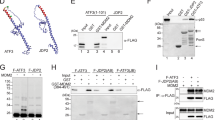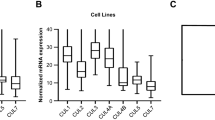Abstract
The ubiquitin (Ub)–proteasome system (UPS) promotes the proteasomal degradation of target proteins by decorating them with Ub labels. Emerging evidence indicates a role of UPS in regulating gene transcription. In this study, we provided evidence for the involvement of UPS in the transcriptional activation function of tumor suppressor p53. We showed that both ubiquitylation and proteasomal functions are required for efficient transcription mediated by p53. Disruption of transcription by actinomycin D, 5,6-dichloro-1-β-D-ribofuranosyl-benzimadazole or α-amanitin leads to accumulation of cellular p53 protein. Proteasome inhibition by MG132 increases the occupancy of p53 protein at p53-responsive p21waf1 promoter. In addition, the Sug-1 component of 19S proteasome physically interacts with p53 in vitro and in vivo. Moreover, in response to ultraviolet-induced DNA damage, both the 19S proteasomal components, Sug1 and S1, are recruited to p21waf1 promoter region in a kinetic pattern similar to that of p53. These results suggested that UPS positively regulates p53-mediated transcription at p21waf1 promoter.
This is a preview of subscription content, access via your institution
Access options
Subscribe to this journal
Receive 50 print issues and online access
$259.00 per year
only $5.18 per issue
Buy this article
- Purchase on Springer Link
- Instant access to full article PDF
Prices may be subject to local taxes which are calculated during checkout






Similar content being viewed by others
References
Adams J, Kauffman M . (2004). Development of the proteasome inhibitor Velcade (Bortezomib). Cancer Invest 22: 304–311.
Bres V, Kiernan RE, Linares LK, Chable-Bessia C, Plechakova O, Treand C et al. (2003). A non-proteolytic role for ubiquitin in Tat-mediated transactivation of the HIV-1 promoter. Nat Cell Biol 5: 754–761.
Brooks CL, Gu W . (2006). p53 ubiquitination: Mdm2 and beyond. Mol Cell 21: 307–315.
Conaway JW, Shilatifard A, Dvir A, Conaway RC . (2000). Control of elongation by RNA polymerase II. Trends Biochem Sci 25: 375–380.
DeMartino GN, Slaughter CA . (1999). The proteosome, a novel protease regulated by multiple mechanisms. J Biol Chem 274: 22123–22126.
Dvir A, Conaway JW, Conaway RC . (2001). Mechanism of transcription initiation and promoter escape by RNA polymerase II. Curr Opin Genet Dev 11: 209–214.
El-Deiry WS . (1998). p21/p53, cellular growth control and genomic integrity. Curr Top Microbiol Immunol 227: 121–137.
Ferdous A, Gonzalez F, Sun L, Kodadek T, Johnston SA . (2001). The 19S regulatory particle of the proteasome is required for efficient transcription elongation by RNA polymerase II. Mol Cell 7: 981–991.
Ferdous A, Kodadek T, Johnston SA . (2002). A nonproteolytic function of the 19S regulatory subunit of the 26S proteasome is required for efficient activated transcription by human RNA polymerase II. Biochemistry 41: 12798–12805.
Finley D, Ciechanover A, Varshavsky A . (1984). Thermolability of ubiquitin-activating enzyme from the mammalian cell cycle mutant ts85. Cell 37: 43–55.
Gianni M, Bauer A, Garattini E, Chambon P, Rochette-Egly C . (2002). Phosphorylation by p38MAPK and recruitment of SUG-1 are required for RA-induced RAR gamma degradation and transactivation. EMBO J 21: 3760–3769.
Gillette TG, Gonzalez F, Delahodde A, Johnston SA, Kodadek T . (2004). Physical and functional association of RNA polymerase II and the proteasome. Proc Natl Acad Sci USA 101: 5904–5909.
Glickman MH, Ciechanover A . (2002). The ubiquitin–proteasome proteolytic pathway: destruction for the sake of construction. Physiol Rev 82: 373–428.
Glickman MH, Rubin DM, Fried VA, Finley D . (1998). The regulatory particle of the Saccharomyces cerevisiae proteasome. Mol Cell Biol 18: 3149–3162.
Gonzalez F, Delahodde A, Kodadek T, Johnston SA . (2002). Recruitment of a 19S proteasome subcomplex to an activated promoter. Science 296: 548–550.
Grossman SR, Deato ME, Brignone C, Chan HM, Kung AL, Tagami H et al. (2003). Polyubiquitination of p53 by a ubiquitin ligase activity of p300. Science 300: 342–344.
Hartwell LH, Kastan MB . (1994). Cell cycle control and cancer. Science 266: 1821–1828.
Haupt Y, Maya R, Kazaz A, Oren M . (1997). Mdm2 promotes the rapid degradation of p53. Nature 387: 296–299.
Imhof MO, McDonnell DP . (1996). Yeast RSP5 and its human homolog hRPF1 potentiate hormone-dependent activation of transcription by human progesterone and glucocorticoid receptors. Mol Cell Biol 16: 2594–2605.
Kern SE, Pietenpol JA, Thiagalingam S, Seymour A, Kinzler KW, Vogelstein B . (1992). Oncogenic forms of p53 inhibit p53-regulated gene expression. Science 256: 827–830.
Kim J, Hake SB, Roeder RG . (2005). The human homolog of yeast BRE1 functions as a transcriptional coactivator through direct activator interactions. Mol Cell 20: 759–770.
Kubbutat MH, Jones SN, Vousden KH . (1997). Regulation of p53 stability by Mdm2. Nature 387: 299–303.
Lee JW, Ryan F, Swaffield JC, Johnston SA, Moore DD . (1995). Interaction of thyroid-hormone receptor with a conserved transcriptional mediator. Nature 374: 91–94.
Levine AJ . (1997). p53, the cellular gatekeeper for growth and division. Cell 88: 323–331.
Lin L, Ozaki T, Takada Y, Kageyama H, Nakamura Y, Hata A et al. (2005). topors, a p53 and topoisomerase I-binding RING finger protein, is a coactivator of p53 in growth suppression induced by DNA damage. Oncogene 24: 3385–3396.
Lipford JR, Deshaies RJ . (2003). Diverse roles for ubiquitin-dependent proteolysis in transcriptional activation. Nat Cell Biol 5: 845–850.
Lipford JR, Smith GT, Chi Y, Deshaies RJ . (2005). A putative stimulatory role for activator turnover in gene expression. Nature 438: 113–116.
Ljungman M, Zhang FF, Chen F, Rainbow AJ, McKay BC . (1999). Inhibition of RNA polymerase II as a trigger for the p53 response. Oncogene 18: 583–592.
Malik S, Roeder RG . (2005). Dynamic regulation of pol II transcription by the mammalian mediator complex. Trends Biochem Sci 30: 256–263.
Molinari E, Gilman M, Natesan S . (1999). Proteasome-mediated degradation of transcriptional activators correlates with activation domain potency in vivo. EMBO J 18: 6439–6447.
Muratani M, Tansey WP . (2003). How the ubiquitin–proteasome system controls transcription. Nat Rev Mol Cell Biol 4: 192–201.
Nawaz Z, Lonard DM, Smith CL, Lev-Lehman E, Tsai SY, Tsai MJ et al. (1999). The Angelman syndrome-associated protein, E6-AP, is a coactivator for the nuclear hormone receptor superfamily. Mol Cell Biol 19: 1182–1189.
O’Hagan HM, Ljungman M . (2004). Nuclear accumulation of p53 following inhibition of transcription is not due to diminished levels of MDM2. Oncogene 23: 5505–5512.
Rajendra R, Malegaonkar D, Pungaliya P, Marshall H, Rasheed Z, Brownell J et al. (2004). Topors functions as an E3 ubiquitin ligase with specific E2 enzymes and ubiquitinates p53. J Biol Chem 279: 36440–36444.
Reid G, Hubner MR, Metivier R, Brand H, Denger S, Manu D et al. (2003). Cyclic, proteasome-mediated turnover of unliganded and liganded ERalpha on responsive promoters is an integral feature of estrogen signaling. Mol Cell 11: 695–707.
Roeder RG . (1996). The role of general initiation factors in transcription by RNA polymerase II. Trends Biochem Sci 21: 327–335.
Saccani S, Pantano S, Natoli G . (2001). Two waves of nuclear factor kappaB recruitment to target promoters. J Exp Med 193: 1351–1359.
Saleh A, Collart M, Martens JA, Genereaux J, Allard S, Cote J et al. (1998). TOM1p, a yeast hect-domain protein which mediates transcriptional regulation through the ADA/SAGA coactivator complexes. J Mol Biol 282: 933–946.
Salghetti SE, Caudy AA, Chenoweth JG, Tansey WP . (2001). Regulation of transcriptional activation domain function by ubiquitin. Science 293: 1651–1653.
Salghetti SE, Muratani M, Wijnen H, Futcher B, Tansey WP . (2000). Functional overlap of sequences that activate transcription and signal ubiquitin-mediated proteolysis. Proc Natl Acad Sci USA 97: 3118–3123.
Siliciano JD, Canman CE, Taya Y, Sakaguchi K, Appella E, Kastan MB . (1997). DNA damage induces phosphorylation of the amino terminus of p53. Genes Dev 11: 3471–3481.
Swaffield JC, Melcher K, Johnston SA . (1995). A highly conserved ATPase protein as a mediator between acidic activation domains and the TATA-binding protein. Nature 374: 88–91.
Szak ST, Mays D, Pietenpol JA . (2001). Kinetics of p53 binding to promoter sites in vivo. Mol Cell Biol 21: 3375–3386.
Varshavsky A . (1997). The ubiquitin system. Trends Biochem Sci 22: 383–387.
Venkatachalam S, Denissenko MF, Wani AA . (1995). DNA repair in human cells: quantitative assessment of bulky anti-BPDE DNA adducts by non-competitive immunoassays. Carcinogenesis 16: 2029–2036.
vom Baur E, Zechel C, Heery D, Heine MJ, Garnier JM, Vivat V et al. (1996). Differential ligand-dependent interact. EMBO J 15: 110–124.
Wang D, Moriggl R, Stravopodis D, Carpino N, Marine JC, Teglund S et al. (2000). A small amphipathic alpha-helical region is required for transcriptional activities and proteasome-dependent turnover of the tyrosine-phosphorylated Stat5. EMBO J 19: 392–399.
Wani MA, Zhu QZ, El-Mahdy MA, Wani AA . (1999). Influence of p53 tumor suppressor protein on bias of DNA repair and apoptotic response in human cells. Carcinogenesis 20: 765–772.
Wu X, Bayle JH, Olson D, Levine AJ . (1993). The p53-mdm-2 autoregulatory feedback loop. Genes Dev 7: 1126–1132.
Zhu Q, Yao J, Wani G, Chen J, Wang QE, Wani AA . (2004). The ubiquitin–proteasome pathway is required for the function of the viral VP16 transcriptional activation domain. FEBS Lett 556: 19–25.
Acknowledgements
We thank Drs Bert Vogelstein for p53 expression constructs and p53-responsive reporters, Moshe Oren for GAL4-p53 constructs, Jeffrey E Kudlow for GST-Sug-1 constructs. We also thank Drs Michael Tainsky for providing Li–Fraumeni syndrome cell lines and Fumio Hanaoka for providing FM3A and ts85 cell lines. We are grateful to Dr Jianming Chen for help with some pull-down experiments and Dr Song Qin for critical reading of the manuscript. The work was supported by Public Health Service Grants ES02388 and ES12991 from NIEHS and CA93413 from NCI.
Author information
Authors and Affiliations
Corresponding author
Additional information
Supplementary Information accompanies the paper on the Oncogene website (http://www.nature.com/onc).
Supplementary information
Rights and permissions
About this article
Cite this article
Zhu, Q., Wani, G., Yao, J. et al. The ubiquitin–proteasome system regulates p53-mediated transcription at p21waf1 promoter. Oncogene 26, 4199–4208 (2007). https://doi.org/10.1038/sj.onc.1210191
Received:
Revised:
Accepted:
Published:
Issue Date:
DOI: https://doi.org/10.1038/sj.onc.1210191
Keywords
This article is cited by
-
Cell cycle–dependent localization of the proteasome to chromatin
Scientific Reports (2020)
-
High nuclear expression of proteasome activator complex subunit 1 predicts poor survival in soft tissue leiomyosarcomas
Clinical Sarcoma Research (2016)
-
The degradation of p53 and its major E3 ligase Mdm2 is differentially dependent on the proteasomal ubiquitin receptor S5a
Oncogene (2014)
-
Roles for common MLL/COMPASS subunits and the 19S proteasome in regulating CIITA pIV and MHC class II gene expression and promoter methylation
Epigenetics & Chromatin (2010)
-
Association of the 19S proteasomal ATPases with the ATPase‐binding domain of CIITA is essential for CIITA stability and MHC class II expression
Immunology & Cell Biology (2010)



